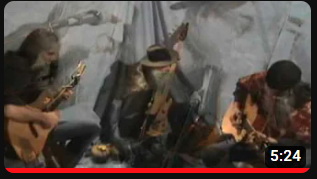 Have you ever changed a boxcar door on a train? I have. For a while there, about a thousand years ago, I worked on the "rip track" for the Rock Island Railroad. I was young and full of cheap beer. I had a rock and roll band and we played Foghat covers on the weekends. We mostly played in the drummer's basement.
Have you ever changed a boxcar door on a train? I have. For a while there, about a thousand years ago, I worked on the "rip track" for the Rock Island Railroad. I was young and full of cheap beer. I had a rock and roll band and we played Foghat covers on the weekends. We mostly played in the drummer's basement.I kept my day job. The money was really good. Union Crane Operator in the 70s. Easy Money. The rip track is where trains go to get repaired. We kept them up to code, we changed knuckles and wheels, we straightened and repaired ladders and catwalks and whatnot. We would heat stuff up with torches and hit it with big hammers. We used welders and huge pneumatic jacks, two of which could lift the ass end of a train a foot off the ground... in seconds. Set the jack, hit the pneumatics, BAM! Train, up in the air.
We also changed boxcar doors. Boxcar doors are huge. Think about it. They cover the hole in THE SIDE OF A TRAIN! So changing them is not as easy as it sounds. It takes manpower, chain hoists or come-alongs and a crane. I drove the crane.
When a boxcar door needs changing it is because it is broken, bent or otherwise useless in its function, which is to keep stuff from falling off the train. About a thousand years ago, this is roughly the way our rip track worked: the inspectors inspected every car of every train. When they found something wrong they hung a tag on it with things that needed fixing. The car got side-railed and eventually it got tacked onto a train headed for our yard. When it got there it was switched over to the rip track and put on one of our 3-track sections (about 4 football fields long). These were our trains.
I managed to get lucky and work my way up quickly. I started as an oiler, changing wheel pads and oil in the snow. That job sucked hard. First, take Illinois in the winter, which is cold enough, then add wind and miles of cold steel. This meant you dressed in your snow suit like a little kid and waddled around the yard like a toddler. Leannnnning foooorward and stepstepstepstep.
Between the wheels of the train was an oil box; in it, a replaceable bearing plate called "the brass" (though it was not made of brass), and an oil pad sitting in a gallon or so of thick, black, stinky oil. It is often frozen. Your job, should you decide to accept the premise that money is worth more than dignity, was to plunk your michelin-man snow-suited ass down in the snow, straddle the thing with the rail under your knees, wrestle that pad out of that mess and change it. This required that you use a hook that looked kind of like one of those keys once used to turn on sprinklers, hook the loop of the big pad and pull. When it was frozen you 'd chip away at the ice with the hook until you could move it or you 'd set the whole thing on fire until it melted... if no white hats were near.
For the first couple of days on the job, the stinky, oil-soaked, sometimes-on-fire pad came flying out when you least expected it and landed on you somewhere usually your crotch. Instead of quitting I worked harder and smarter. I was whipping those things out of there like a boss in no time and was quickly promoted to Carmen's Helper. That meant that the Carmen would make stuff red with the torch and I would hit it with the big hammer (BFH) until it was straight or fell off, whichever came first. Again working hard, learning quickly and shmoozing the right people landed me a ride-along on the crane. There I was trained by Vic, the old guy that had been sitting in that crane since it was new. His sick day replacement had moved and they needed two guys other than him that could run it. He was amazing; that thing was a part of his arm. It was incredible to watch him manipulate weight. He could sense "center," he could run full bore down the aisle and the hook would hang dead vertical. It was frightening but I learned more about physics from that guy than I would have in school. This old, wrinkled guy in overalls whose hand shook when he drank coffee could put out a cigarette sitting on a china plate with the hook out at full boom and won 10 bucks from every single newbie in the yard, including me, proving it. When he retired, I got the job and a raise based on his recommendation. I cried. I spent a lot of hours in the cab with that guy, shootin' the shit and talking railroad history. It was a fascinating perspective from a story teller who was usually all alone in the cab of a rip-track crane watching history go by.
100-ton, high-roof boxcars are over 50' long. The door measures 12' x 12'4" and is heavy enough to tip the little crane over if you pick it up wrong. We usually had a huge pile of new doors down at the end of our run in a yard on the outside of Track 3 and we had another segment of track we called the boneyard, that had a row of cars we were just using for parts.
So, a car would come in with a tag on it. A supervisor would read the tag and assign the car to a Carmen, of which we had several. The Carmen had two helpers - usually a Carmen's helper and a newb - they also had a cart full of tools and a really big acetylene torch. The rest of us floated. I drove the cranes and forklifts and whatnot, there were two floating welders, a few painters, an electrician, a few oilers and so on. There were other crews but this was ours. We had our own maintenance crew for the vehicles and tools. We also had a shed with nuts and bolts and miscellaneous parts and supplies that was well stocked frequently. We had a tool shed with the oddball specialty tools in it, pneumatic jacks and hammers and spreaders and wrenches that did specific things, some 3 feet long. All the tools were cartoonishly large and heavy and everything wanted to kill you. Gas-powered wheel cutters that could cut a train or a Carmen in half, electric chain hoists that, when the chain broke, it took your arm with it. Everything was after you, corners of steel nibbled on your outerwear till the wind got in. You soil your underwear when something large and/or hot hisses by, missing you by (pinchyfingers)"that much." Your steel-toed boots got bent the first week you had them so you have to dip your toes under the steel to get in them and if you had your hood up under your hardhat you could hang yourself on a random ladder rung. Torches and hammers and men in boots: make it red, hit it hard, make it straight, clear the card.
There was also a lunch room and a tank shed where the acetylene and oxygen tanks were stored with the other flammables. Other random hiding places from the biting wind as well as fire barrels every so often. 55 gallon bum-drums full of fire and coke if we could find it. Our union made sure you could pretty much take 5 whenever you needed to warm up or catch a smoke and the gossip. Like old women they were: "Did you hear about so-n-so?" "No, did I tell you about the explosion?" Mostly it was who got hurt or nearly killed and who got promoted and clearly envied, how much they were making now. Sumbitch.
So I get there in the morning and start the diesel crane up which, in the winter in Illinois, means start the heater under the hood, scrape the ice off the windshield and side enough to see out, up and to the mirrors - amid much standing by the bum-drum drinking thermos coffee and spreading gossip. When it was warm enough, you could crank over the engine and turn the heater and defroster on, stand by the bum-drum. If you got wind that there was a coke gondola, a five-gallon bucket with a piece of coke made red hot in a bum-drum worked way better than the little heater that always broke before too long. Man, that made it warm in there. The fumes would kill you, though, if you didn't leave the windows open. Once you were up and running you drove over and checked with the Carmen to see what was on the card. If there was a boxcar door to be done you had to take care of stuff first 'cause it took a while. Bringing parts, lifting stuff, moving cars around until you had a good long window to work in. Once done you had to gather up a few guys to go get the old door off.
So just like in a bad cartoon the hairy crane guy drives up to the train with several other hairy guys hanging off the sides of the thing and maybe one guy riding the hook. If they had all morning to work on it they are ready for you and all you have to do is pick it and stick it. They would have pulled it out of the track and hung it from chains from the other side of the train and put a choker on it. Some poor guy would be sitting up there in the winter wind waiting for you so he could set the hook. Take the weight, they take the chains off, you swing away and center the weight while your helpers grab taglines and keep it from spinning. The space between the cars is only a foot wider than a boxcar door. With the little crane if you held it up high enough and kept it parallel to the boom you could see but it would tip the crane forward at the first good bump in the road. So the taglines were used to angle it perpendicularish to the boom and therefore the driver couldn't see anything past it. So again the cartoon would begin. With guys walking on top of trains and other guys hanging off the crane, we would gently guide the thing down the track to the bone pile, grab a new one and slowly make our way back with sign language and lots of yelling of obscenities and navigation data the entire way: "Inch right, true, f%&k you. Left left you c&*#sucker, your other left!" until we were there. Then we'd spin it and boom over until they could get chains on it. I'd help get it positioned and started on the track, they'd tie it off and let me go. I'd back up and get as close as I dared and boom down until the boomhead could push it on to the track. The trouble with that not-exactly-by-the-book technique became rather apparent to me the day I nearly crushed 5 guys with a train.
It was a comedy of errors. You are supposed to disconnect the car from the train on both sides before you start. You must get the angle of boom-to-train right. No one is supposed to be on that side when you push. That chain isn't supposed to break, it 's supposed to slide.
The car was not disconnected, I had the angle wide, the nearest bum-drum was in the wrong place, the chain broke. Hung by two long chains on chain hoists and one end started in the track, just like your closet door, you had to push the door onto the track. Guy would release more chain as it slid in and then release one and then the other as it went in. When I pushed and the chain broke, the door no longer lined up properly and jammed in the slot. When I pushed harder I picked up the train. Five empty, top-heavy cars came up off the track on one side nearly a foot. If something that tall sits on something that narrow and is top-heavy it has a tendency to tip over if it goes just so far that the center of gravity shifts. Five of my friends were warming their hands over a bum-drum on the other side, two guys jumped off the top, sliding down ladders like in the movies. I stopped, micro moved the boom in as it hung there in slo-motion and then it finally came right back down with the most amazing sound ever. kabamooooshrattlerattle. Man, what a sound! Everything landed back on track and we all just stood still for a second. I will never forget it. That sound. It was enormously loud and the ground shook a little. It also meant my friends were safe and I didn't kill anyone that day.
It was terrifying. I nearly knocked a train over on some guys. The oddest thing happened afterwards. Everyone came running, everyone was ok and everyone just went back to work. They threw another chain on it and made the track red and hit it with a hammer. We disconnected the damn car from the train and I repositioned the crane with many helpful obscenities from my very-alive friends. We set the door, I waved and collected my helpers and off we went on our next adventure. After the day, at the bar, the boys were bragging about nearly getting killed, trying to use it to get laid, shootin' pool, drinking happy hour pitchers that I, of course, had to pay for, laughing, like nothing happened because of course, nothing did. Except, I nearly killed all my friends that day cause I had the angle wrong...



